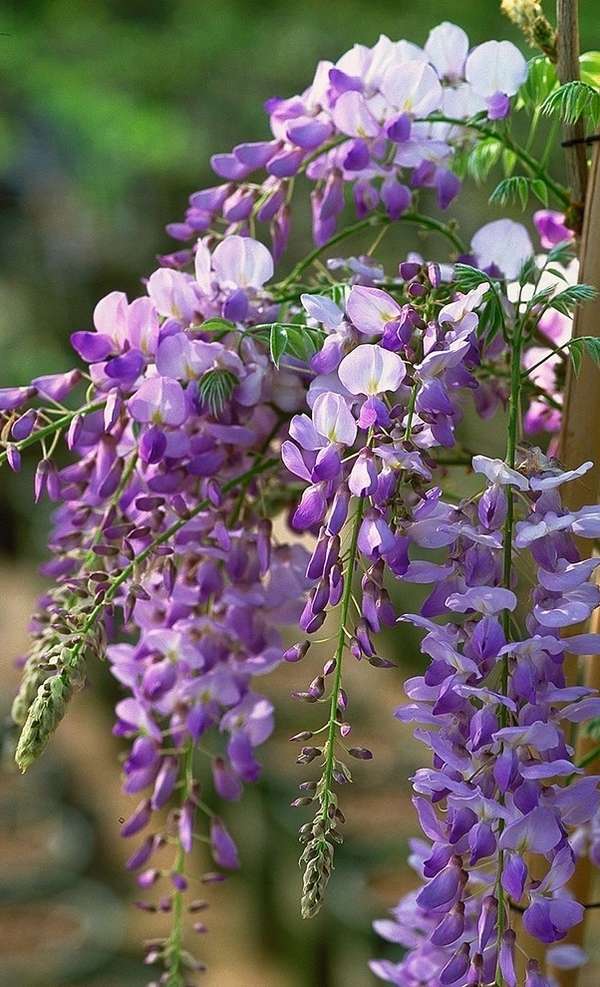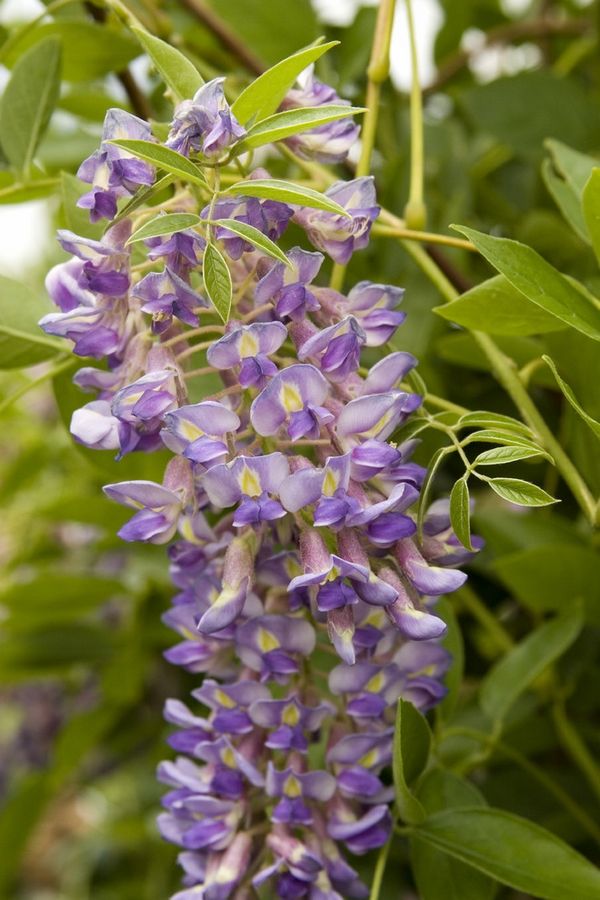A blooming wisteria vine is a fascinating swirl of bright colors – beautiful clusters of purple, blue, pink and white that emit a sweet fragrance and have an irresistible waterfall appearance. Wisteria is widely used in landscape design as they can climb high walls, fences or pergolas, pillars and lattices and you can disguise a visually unattractive part of the garden, you can zone the yard with fabulous green screens and get protection and shelter from wind and sun.
In nature wisteria plant is a deciduous woody vine with drooping branches, reaching 15-18 meters in height. The original species came from Japan, Korea, China, Central and Southern USA. Wisteria blooms in the spring, in late March and can bloom throughout the summer. In landscape it is used as vines or trees, sometimes it can be container grown and its popularity id due to the fact that it has an enormous decorative value and in addition it does not occupy a lot of space. However, the root systems can destroy underground plumbing and crack concrete slabs as it spreads about forty feet wide. In addition, vines can tear the siding and gutters right off your home so choosing the right location is essential.
Wisteria is a genus of flowering plants in the pea family but if you have plans to plant it in your backyard you should know that when you raise it from seed, it can take up to 20 years or more to flower, so buying one at a nursery already in flower is a better idea if you want to enjoy this plant. We shall look at the different species and will give you helpful advice on how to grow wisteria, what is the suitable place for your tree, how to water your plants as well as how to prune them.
Wisteria vine species – what is the difference between wisteria tree and wisteria vine?
Many people wonder what the difference between wisteria tree and wisteria vine is. There is no difference except that the vine is grown and pruned to grow as a standing tree. There are many different species of wisteria but the two major and most popular species are Chinese Wisteria (W. sinensis) and Japanese wisteria (W. floribunda). Both Chinese and Japanese wisterias are drought resistant plants and have fantastic blooms resembling grapes.
Besides Japanese and Chinese wisteria, also popular are W. brachybotrys (The Silky Wisteria), sometimes called Wisteria venusta, W. brachybotrys Alba with white flowers and yellow centrals, Wisteria venusta Violacea with deep violet blue flowers and yellowish centrals, Wisteria formosa which is a cross between W. floribunda and W. sinensis varieties are also widely used in landscape designs.Wisteria Praecox, Wisteria Purpurea, Wisteria Rosea are varieties of the Japanese wisteria with beautiful colors. Chinese wisteria species are more popular because they are less capricious and bloom profusely.
What is the difference between Chinese and Japanese plants? Chinese wisteria twines anti-clockwise and its flowers appear before the foliage is developed and reach a length of 23-30cm (9-12″). The stems of Japanese wisteria twine clockwise, the flowers appear at same time as foliage and reach a length of 30-45cm (12-18″).
Chinese wisteria has three popular varieties:
- white Chinese wisteria (Wisteria sinensis Alba) with white flowers which bloom in spring and early summer.
- Wisteria sinensis ‘Prolific’ – with an abundance of scented pendants of lilac-blue flowers, reaching a mature height of 9m (28′).
- Wisteria ‘Sierra Madre’ ( ‘Sierra Madre’) – with lavender-violet flowers and white centers. The world’s largest known plant is in Sierra Madre, California, measuring more than 1 acre (0.40 ha) in size and weighing 250 tons.
Japanese wisteria also has some popular varieties:
- W. floribunda Alba – with very fragrant white flowers that can reach 20’ (50cm) or more.
- W. floribunda Black Dragon (or Royal Purple) – it has rich deep purple, long flowers reaching 20in (50cm).
- W. floribunda Rosea (Honka) is distinguished by its sweetly scented, delicate pink flowers reaching 18in (45cm) length.
- W.a floribunda Macrobotrys (or Kyushaku) is a spectacular type of wisteria with lilac blue flowers which can reach 3 ft (90cms) in length.
You should know that the plant is not an evergreen. It is a deciduous plant with beautiful autumn color. The foliage gets richly yellow with orange shades.
How to grow wisteria vines – where and when to plant, how to water the plant
Growing wisteria requires some knowledge and we shall give you some guidelines which will help you enjoy this magnificent plant all summer long. One of the most important factors is the location of the plant. It has a long life and over time it forms woody stems which means that it requires a durable support. Keep in mind than moving a plant can be difficult. In addition the plant requires a regular pruning so you have to be able to access the plants. Choose a sunny or semi shaded site in moist, well drained soil and if possible a sheltered site to prevent eventual damage on the flower buds from spring frosts.
When to plant wisteria vines? Vines are planted in the spring, when the last frosts have passed. All varieties are cold-resistant, but it is better not to expose young plants are at risk of frostbite. It needs plenty of bright sunlight to blossom abundantly – six or more hours a day and deep, moderately fertile, moist soil. Although it adapts to different types of soil, it is preferably to plant it in a soil that is preferably neutral to slightly acidic, with a pH of 6.0-7.0. To prepare the soil for planting – check the pH and the levels of phosphorus. Dig a hole of about one meter and add well rotted manure or garden compost to the soil to improving the quality of soil, fertility and ensure the drainage. Once the soil is prepared, wisteria can be planted. If the plant is cultivated, the graft must be buried in shallow depth. Young plants are fertilized annually. Do not expect a young plant to blossom.
It is better to provide support and adequate framework for the vine variety as it is a good climber – it can be pergolas, gazebos, even on vertical walls as long as you have a strong support at a distance of 4-6 cm. It is best to put the support in place before or at the time of planting as it will be much harder to install them once the wisteria is in the ground. If you use metal support choose a material that does not rust.
Watering – Wisteria vine does not like too much moist. Excessive moisture can cause leaf and buds shedding. From the beginning of flowering until the end of summer, moderate watering is needed – the soil should be only slightly damp. In order to avoid stagnant water at the root in hot weather it is better to water the plant with a sprayer. In September watering is virtually stopped – the plant growth slows down and it begins to prepare for winter.
How to prune?
Now, we come to the hard part – how to prune wisteria vine. The plant is pruned several times throughout the year, but if you think this is too much, you can prune it twice a year – once in late winter (February) to prepare the flowering spurs for the forthcoming season, and again in mid-summer (July to August). Prune all the new shoots back to two or three leaves from the base of the new growth. Proper and timely pruning are essential for an abundant flowering. The summer pruning controls the long shoots that are heading off into the distance, and encourages them to become flowering spurs instead.
Diseases and pests -Wisteria vine is resistant to disease and pests attacks are rare, but it can be attacked by caterpillars, green aphids, leaf hoppers, leaf miners, scale insects, mealybugs and clover mites. Plant purple hyacinths, daffodils and white tulips at the foot of tree or vines to repel pests. Keep in mind that when blooming the vines are a magnet for bees, so if someone in the household is allergic, carefully consider whether to plant or not wisteria in your backyard.
Problems that you may have
The biggest disappointment for the gardener is to buy a young plant and it does not blossom. There are a number of reasons why wisteria is not flowering. One of them is the wrong pruning. If not pruned properly, twice a year in July/ August and again in February, it may lead to lack of flowers. Seed raised plants take many years to flower. It is recommended to buy a plant with graft or propagated by cutting. Lack of watering is another reason. Wisteria should be watered regularly in the period July – September ad this is the period when the buds are formed for next year’s flowers. Spring frosts could also be a reason for the lack of flowers as the new buds drop.
Wisteria is one of the favorite plants of gardeners, exterior designers and landscape architects. It adorns the entrance of the house, pergolas, gazebos, facade walls, garden fences, garden walls, and in the flowering period the spectacular cascades of its large and lush pendant clusters attract the eyes and exude a beautiful fragrance. This plant, with its many species and varieties, is one of the most beautiful vines in landscape design.







































